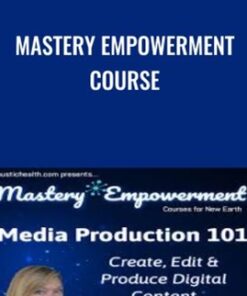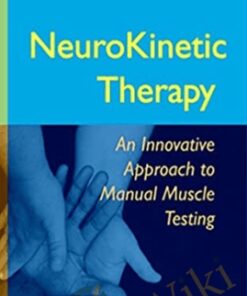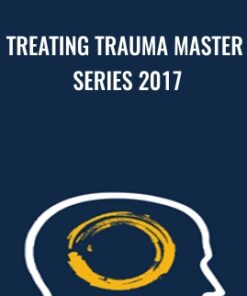Certified Clinical Anxiety Treatment Professional (CCATP) Training Course: Applied Neuroscience for Treating Anxiety, Panic, and Worry – Catherine M. Pittman
Question and Answer
What is comprehensive certificate training,?
comprehensive certificate training, is In this new, you’ll see how neuroscience can inform why, how and what techniques can help your clients stop the symptoms of anxiety — even the tough to treat panic attacks, worry, rumination, nausea, and pounding hearts..
How does comprehensive certificate training, see?
In this new, comprehensive certificate training, you’ll see how neuroscience can inform why, how and what techniques can help your clients stop the symptoms of anxiety — even the tough to treat panic attacks, worry, rumination, nausea, and pounding hearts.
What is Certified Clinical Anxiety Treatment Professional (CCATP) Training Course:?
Certified Clinical Anxiety Treatment Professional (CCATP) Training Course: is Purchase Applied Neuroscience for Treating Anxiety, Panic, and Worry - Catherine M. Pittman courses at here with PRICE $399.99 $125 Advances in neuroscience have provided a roadmap for the brain that shows us the key to working with anxious minds..
How does Certified Clinical Anxiety Treatment Professional (CCATP) Training Course: Purchase?
Purchase Certified Clinical Anxiety Treatment Professional (CCATP) Training Course: Applied Neuroscience for Treating Anxiety, Panic, and Worry - Catherine M. Pittman courses at here with PRICE $399.99 $125 Advances in neuroscience have provided a roadmap for the brain that shows us the key to working with anxious minds.
What is the complex map neuroscience?
the complex map neuroscience is But knowing how to interpret provides has left many clinicians wondering… How do I unlock the complicated inner workings of the brain to guide my client sessions?.
How does the complex map neuroscience interpret?
But knowing how to interpret the complex map neuroscience provides has left many clinicians wondering… How do I unlock the complicated inner workings of the brain to guide my client sessions?
What is comprehensive certificate training,?
comprehensive certificate training, is In this new, you’ll see how neuroscience can inform why, how and what techniques can help your clients stop the symptoms of anxiety — even the tough to treat panic attacks, worry, rumination, nausea, and pounding hearts..
How does comprehensive certificate training, see?
In this new, comprehensive certificate training, you’ll see how neuroscience can inform why, how and what techniques can help your clients stop the symptoms of anxiety — even the tough to treat panic attacks, worry, rumination, nausea, and pounding hearts.
What is you?
you is Now can join Catherine Pittman, Ph.D., HSPP, for a comprehensive step by step clinical training on how you can revolutionize your anxiety treatment approach with the power of neuroplasticity..
How does you can join?
Now you can join Catherine Pittman, Ph.D., HSPP, for a comprehensive step by step clinical training on how you can revolutionize your anxiety treatment approach with the power of neuroplasticity.
What is the neurobiological "whats and whys,"?
the neurobiological "whats and whys," is More than just you'll also learn the "hows" of actual treatment — so you’ll know exactly how to empower your clients with strategies to resist anxiety-igniting cognitions..
How does the neurobiological "whats and whys," also learn?
More than just the neurobiological "whats and whys," you'll also learn the "hows" of actual treatment — so you’ll know exactly how to empower your clients with strategies to resist anxiety-igniting cognitions.
What is You’ll?
You’ll is end this course with your Certificate in Applied Neuroscience for Treating Anxiety, Panic and Worry and be fully prepared to integrate brain-based strategies that motivate lasting change for calming the mind — even in your most anxious, worried, traumatized, or obsessive clients..
How does You’ll end?
You’ll end this course with your Certificate in Applied Neuroscience for Treating Anxiety, Panic and Worry and be fully prepared to integrate brain-based strategies that motivate lasting change for calming the mind — even in your most anxious, worried, traumatized, or obsessive clients.
What is you?
you is Now can become a Certified Clinical Anxiety Treatment Professional..
How does you can become?
Now you can become a Certified Clinical Anxiety Treatment Professional.
What is this online certificate course?
this online certificate course is Complete to fulfill the educational requirements you need to advance your career..
How does this online certificate course Complete?
Complete this online certificate course to fulfill the educational requirements you need to advance your career.
What is Today's advances?
Today's advances is in neuroscience have provided us with more evidence-based explanations about the causes and treatment of anxiety-based disorders than any other clinical disorder you'll see in your practice..
How does Today's advances have provided?
Today's advances in neuroscience have provided us with more evidence-based explanations about the causes and treatment of anxiety-based disorders than any other clinical disorder you'll see in your practice.
What is 10 comprehensive modules,?
10 comprehensive modules, is Through you'll learn through easy-to-understand language how you can apply neuroscience to your anxiety treatment plans to effectively and easily modify the processes in the brain that give rise to anxiety — so you can help your clients find deep, lasting relief from panic, worry, trauma, and obsessions..
How does 10 comprehensive modules, learn?
Through 10 comprehensive modules, you'll learn through easy-to-understand language how you can apply neuroscience to your anxiety treatment plans to effectively and easily modify the processes in the brain that give rise to anxiety — so you can help your clients find deep, lasting relief from panic, worry, trauma, and obsessions.
What is Neuroscience?
Neuroscience is Using in the Treatment of Anxiety.
How does Neuroscience Using?
Using Neuroscience in the Treatment of Anxiety
What is Neuroscience?
Neuroscience is How does inform the clinical treatment of anxiety?.
How does Neuroscience does?
How does Neuroscience inform the clinical treatment of anxiety?
What is Module one,?
Module one, is In you will explore the neurological processes behind anxiety..
How does Module one, will explore?
In Module one, you will explore the neurological processes behind anxiety.
What is You'll?
You'll is also learn... How you can help your anxious clients understand their own symptoms, feelings, interpretations, beliefs What to do when treatment strategies for anxiety produce anxiety How to work within the goal of changing the brain rather than the goal of reducing anxiety How neuroplasticity makes the brain more resistant to anxiety Simple explanations you can share clients about how anxiety travels through their brain Module 2:.
How does You'll also learn...?
You'll also learn... How you can help your anxious clients understand their own symptoms, feelings, interpretations, beliefs What to do when treatment strategies for anxiety produce anxiety How to work within the goal of changing the brain rather than the goal of reducing anxiety How neuroplasticity makes the brain more resistant to anxiety Simple explanations you can share clients about how anxiety travels through their brain Module 2:
What is the Amygdala?
the Amygdala is Working with.
How does the Amygdala Working?
Working with the Amygdala
What is Module 2,?
Module 2, is you'll learn how the amygdala fuels anxiety and how amygdala management can improve your client's level of functioning without the use of medication..
How does Module 2, learn?
Module 2, you'll learn how the amygdala fuels anxiety and how amygdala management can improve your client's level of functioning without the use of medication.
What is amygdala management?
amygdala management is Why is essential for all Anxiety Disorders, PTSD, OCD, Depression The amygdala's role in the stress/fear/anxiety response and formation of emotional memories How to train the brain to stop responding to negative anxiety “triggers” The Vagus nerve’s role in recovery from the activation of the sympathetic nervous system Interventions that reduce anxiety "fuel" produced in the amygdala Using exposure: safely activating the fear circuitry created in the amygdala to generate new connections Module 3:.
How does amygdala management is?
Why amygdala management is essential for all Anxiety Disorders, PTSD, OCD, Depression The amygdala's role in the stress/fear/anxiety response and formation of emotional memories How to train the brain to stop responding to negative anxiety “triggers” The Vagus nerve’s role in recovery from the activation of the sympathetic nervous system Interventions that reduce anxiety "fuel" produced in the amygdala Using exposure: safely activating the fear circuitry created in the amygdala to generate new connections Module 3:
What is the Cortex?
the Cortex is Managing.
How does the Cortex Managing?
Managing the Cortex
What is The brain's cortex?
The brain's cortex is plays an "anxiety igniting" role in many anxiety disorders, including: GAD, SAD, OCD, PTSD and also depression, eating disorders and substance abuse..
How does The brain's cortex plays?
The brain's cortex plays an "anxiety igniting" role in many anxiety disorders, including: GAD, SAD, OCD, PTSD and also depression, eating disorders and substance abuse.
What is Module 3,?
Module 3, is In you'll learn tools and strategies for recognizing and managing anxiety driven by the cortex..
How does Module 3, learn?
In Module 3, you'll learn tools and strategies for recognizing and managing anxiety driven by the cortex.
What is You'll?
You'll is also learn... How the cortex constructs reality How to resist the effects of anticipation and the healthy (adaptive) use of worry “Survival of the busiest” principle — strengthen or weaken specific circuitry How to recognize and modify the impact of uncertainty Left hemisphere techniques: How to use cognitive defusion, coping thoughts, and fighting anticipation Right hemisphere techniques: How to use imagery and music Module 4:.
How does You'll also learn...?
You'll also learn... How the cortex constructs reality How to resist the effects of anticipation and the healthy (adaptive) use of worry “Survival of the busiest” principle — strengthen or weaken specific circuitry How to recognize and modify the impact of uncertainty Left hemisphere techniques: How to use cognitive defusion, coping thoughts, and fighting anticipation Right hemisphere techniques: How to use imagery and music Module 4:
What is you?
you is Even when don't prescribe medications, it's important to understand how medication impacts your treatment plan..
How does you don't prescribe?
Even when you don't prescribe medications, it's important to understand how medication impacts your treatment plan.
What is this module,?
this module, is In you'll learn how your partnership with prescribers can improve overall client education on how medication affects clients and their therapeutic goals..
How does this module, learn?
In this module, you'll learn how your partnership with prescribers can improve overall client education on how medication affects clients and their therapeutic goals.
What is The myth?
The myth is of the chemical imbalance Tools for assessing medication use during the initial intake How SSRIs and SNRIs promote neuroplasticity The danger of sedating the brain with benzodiazepines And overview of buspirone, beta blockers and sedatives/hypnotics/z-drugs The effectiveness of CBT and meds Module 5:.
How does The myth assessing?
The myth of the chemical imbalance Tools for assessing medication use during the initial intake How SSRIs and SNRIs promote neuroplasticity The danger of sedating the brain with benzodiazepines And overview of buspirone, beta blockers and sedatives/hypnotics/z-drugs The effectiveness of CBT and meds Module 5:
What is exposure?
exposure is Using can help teach the brain new, positive ways to respond..
How does exposure Using?
Using exposure can help teach the brain new, positive ways to respond.
What is this module,?
this module, is In you'll learn to safely and effectively use exposure strategies to create new emotional learning..
How does this module, learn?
In this module, you'll learn to safely and effectively use exposure strategies to create new emotional learning.
What is Tools?
Tools is for helping clients learn to reduce avoidance and push through anxiety How to prepare clients for exposure: psychoeducation, breathing training, cognitive restructuring In vivo vs..
How does Tools helping?
Tools for helping clients learn to reduce avoidance and push through anxiety How to prepare clients for exposure: psychoeducation, breathing training, cognitive restructuring In vivo vs.
What is imaginal exposure?
imaginal exposure is approaches Interoceptive triggers and methods for exposure Use of Subjective Units of Distress/Discomfort Scale (SUDS) Concerns associated with safety signals, medications, distraction How to troubleshoot problems Module 6:.
How does imaginal exposure approaches?
imaginal exposure approaches Interoceptive triggers and methods for exposure Use of Subjective Units of Distress/Discomfort Scale (SUDS) Concerns associated with safety signals, medications, distraction How to troubleshoot problems Module 6:
What is Our clients?
Our clients is with anxiety or depression may be so tuned into worry or rumination that they aren't aware of their experiences..
How does Our clients may be so tuned?
Our clients with anxiety or depression may be so tuned into worry or rumination that they aren't aware of their experiences.
What is we?
we is When introduce Mindfulness to the anxious brain, we provide an evidence-based avenue for changing the brain to be more resistant to anxiety and its symptoms..
How does we introduce?
When we introduce Mindfulness to the anxious brain, we provide an evidence-based avenue for changing the brain to be more resistant to anxiety and its symptoms.
What is Defining basic emotional reactions:?
Defining basic emotional reactions: is Attachment, Aversion, Indifference How to practice self-acceptance and erase the detrimental effect of judgment Using mindfulness to explore thoughts, sensations, and emotional reactions How to use the power of intention to focus thoughts in new directions Tools for coping with common reactions to aversion Module 7:.
How does Defining basic emotional reactions: practice?
Defining basic emotional reactions: Attachment, Aversion, Indifference How to practice self-acceptance and erase the detrimental effect of judgment Using mindfulness to explore thoughts, sensations, and emotional reactions How to use the power of intention to focus thoughts in new directions Tools for coping with common reactions to aversion Module 7:
What is CBT Interventions?
CBT Interventions is Using Neuropsychologically Informed.
How does CBT Interventions Using Neuropsychologically Informed?
Using Neuropsychologically Informed CBT Interventions
What is this module,?
this module, is In you'll work on increasing the effectiveness of CBT tools by using neurologically informed interventions..
How does this module, work?
In this module, you'll work on increasing the effectiveness of CBT tools by using neurologically informed interventions.
What is You'll?
You'll is learn exactly what to do to use this skills-based approach to help your clients practice new behaviors and strengthen new neural connections to ease their anxiety..
How does You'll learn exactly?
You'll learn exactly what to do to use this skills-based approach to help your clients practice new behaviors and strengthen new neural connections to ease their anxiety.
What is CBT?
CBT is Using and neurological knowledge to strengthen client engagement Advantages of the strategic use of neuroscience in CBT Why focusing on logic and disputing has limits Using skills-based approaches in CBT to provide the brain experiences to learn Module 8:.
How does CBT Using?
Using CBT and neurological knowledge to strengthen client engagement Advantages of the strategic use of neuroscience in CBT Why focusing on logic and disputing has limits Using skills-based approaches in CBT to provide the brain experiences to learn Module 8:
What is Comorbid Depression?
Comorbid Depression is Treating.
How does Comorbid Depression Treating?
Treating Comorbid Depression
What is some estimates?
some estimates is With showing that 60% of those with anxiety will also have symptoms depression, you are likely treating individuals for both disorders..
How does some estimates showing?
With some estimates showing that 60% of those with anxiety will also have symptoms depression, you are likely treating individuals for both disorders.
What is this module,?
this module, is In you'll explore the link between anxiety and depression and learn how you can more effectively improve both disorders through interventions that help make the brain more resistant to anxiety and depression..
How does this module, explore?
In this module, you'll explore the link between anxiety and depression and learn how you can more effectively improve both disorders through interventions that help make the brain more resistant to anxiety and depression.
What is the hippocampus?
the hippocampus is How impacts negative thinking Exercises to help clients focus on the positive Addressing worry, rumination, and common cognitive errors in depression Benefits of goal setting and behavioral activation Key role of social support and social interaction Module 9:.
How does the hippocampus impacts?
How the hippocampus impacts negative thinking Exercises to help clients focus on the positive Addressing worry, rumination, and common cognitive errors in depression Benefits of goal setting and behavioral activation Key role of social support and social interaction Module 9:
What is clients?
clients is When have obsessive, ruminative and worry-based thinking, clinicians can easily get caught up in the process..
How does clients have?
When clients have obsessive, ruminative and worry-based thinking, clinicians can easily get caught up in the process.
What is module 9,?
module 9, is In we’ll cover effective approaches for working with OCD and GAD that ensure we don’t co-obsess..
How does module 9, cover?
In module 9, we’ll cover effective approaches for working with OCD and GAD that ensure we don’t co-obsess.
What is distorted thoughts?
distorted thoughts is How to challenge and unrealistic beliefs and images How to identify and stop anxiety-igniting thoughts common in OCD and GAD Strategies for helping clients embrace uncertainty Making OCD or worry the adversary: Don’t be bullied!.
How does distorted thoughts challenge?
How to challenge distorted thoughts and unrealistic beliefs and images How to identify and stop anxiety-igniting thoughts common in OCD and GAD Strategies for helping clients embrace uncertainty Making OCD or worry the adversary: Don’t be bullied!
What is clients?
clients is Why should schedule obsessions or worries to bring them under control Module 10:.
How does clients should schedule?
Why clients should schedule obsessions or worries to bring them under control Module 10:
What is Reconsolidation Approaches?
Reconsolidation Approaches is Using.
How does Reconsolidation Approaches Using?
Using Reconsolidation Approaches
What is Breakthrough research?
Breakthrough research is shows we can modify and erase old memories through reactivation – which can reduce anxiety symptoms quickly..
How does Breakthrough research shows?
Breakthrough research shows we can modify and erase old memories through reactivation – which can reduce anxiety symptoms quickly.
What is this final module,?
this final module, is In you'll explore step-by-step how to safely use therapeutic memory reconsolidation to improve anxiety treatment..
How does this final module, explore?
In this final module, you'll explore step-by-step how to safely use therapeutic memory reconsolidation to improve anxiety treatment.
What is implicit emotional learning?
implicit emotional learning is Explaining and identifying examples How to assist the client to experience the memory structure in the present moment How to promote your client’s experiential learning of emotional truth Steps for disconfirming the emotional memory with “mismatching” information that invalidates it Are you ready to step into the life awaiting you as a Certified Clinical Anxiety Treatment Professional?.
How does implicit emotional learning Explaining?
Explaining implicit emotional learning and identifying examples How to assist the client to experience the memory structure in the present moment How to promote your client’s experiential learning of emotional truth Steps for disconfirming the emotional memory with “mismatching” information that invalidates it Are you ready to step into the life awaiting you as a Certified Clinical Anxiety Treatment Professional?
What is Certified and Go Further...?
Certified and Go Further... is Get.
How does Certified and Go Further... Get?
Get Certified and Go Further...
What is a Certified Clinical Anxiety Treatment Professional?
a Certified Clinical Anxiety Treatment Professional is Become and show your employer, clients, potential clients and fellow professionals your commitment to honing your skills and staying up to date on anxiety treatment best-practices..
How does a Certified Clinical Anxiety Treatment Professional Become?
Become a Certified Clinical Anxiety Treatment Professional and show your employer, clients, potential clients and fellow professionals your commitment to honing your skills and staying up to date on anxiety treatment best-practices.
What is your peers?
your peers is Distinguish yourself from and increase your opportunities for career advancement, earning potential, and client growth..
How does your peers Distinguish?
Distinguish yourself from your peers and increase your opportunities for career advancement, earning potential, and client growth.
What is Certification?
Certification is is a personal accomplishment and unbiased barometer of your skills..
How does Certification is?
Certification is a personal accomplishment and unbiased barometer of your skills.
What is assurance?
assurance is Provide to consumer and clients when you display your certification..
How does assurance Provide?
Provide assurance to consumer and clients when you display your certification.
What is you?
you is When complete your certification, they can be confident you are providing them with the best tools and strategies for improving clinical outcomes..
How does you complete?
When you complete your certification, they can be confident you are providing them with the best tools and strategies for improving clinical outcomes.
What is "Certified Clinical Anxiety Treatment Professional (CCATP) Training Course:?
"Certified Clinical Anxiety Treatment Professional (CCATP) Training Course: is Tag: Applied Neuroscience for Treating Anxiety, Panic, and Worry - Catherine M. Pittman" Review..
How does "Certified Clinical Anxiety Treatment Professional (CCATP) Training Course: Tag:?
Tag: "Certified Clinical Anxiety Treatment Professional (CCATP) Training Course: Applied Neuroscience for Treating Anxiety, Panic, and Worry - Catherine M. Pittman" Review.
What is "Certified Clinical Anxiety Treatment Professional (CCATP) Training Course:?
"Certified Clinical Anxiety Treatment Professional (CCATP) Training Course: is Applied Neuroscience for Treating Anxiety, Panic, and Worry - Catherine M. Pittman" download..
How does "Certified Clinical Anxiety Treatment Professional (CCATP) Training Course: Panic,?
"Certified Clinical Anxiety Treatment Professional (CCATP) Training Course: Applied Neuroscience for Treating Anxiety, Panic, and Worry - Catherine M. Pittman" download.
What is "Certified Clinical Anxiety Treatment Professional (CCATP) Training Course:?
"Certified Clinical Anxiety Treatment Professional (CCATP) Training Course: is Applied Neuroscience for Treating Anxiety, Panic, and Worry - Catherine M. Pittman" discount..
How does "Certified Clinical Anxiety Treatment Professional (CCATP) Training Course: Panic,?
"Certified Clinical Anxiety Treatment Professional (CCATP) Training Course: Applied Neuroscience for Treating Anxiety, Panic, and Worry - Catherine M. Pittman" discount.
What is Certified Clinical Anxiety Treatment Professional (CCATP) Training Course:?
Certified Clinical Anxiety Treatment Professional (CCATP) Training Course: is Purchase Applied Neuroscience for Treating Anxiety, Panic, and Worry - Catherine M. Pittman courses at here with PRICE $399.99 $125.
How does Certified Clinical Anxiety Treatment Professional (CCATP) Training Course: Purchase?
Purchase Certified Clinical Anxiety Treatment Professional (CCATP) Training Course: Applied Neuroscience for Treating Anxiety, Panic, and Worry - Catherine M. Pittman courses at here with PRICE $399.99 $125
 2-Day: Bulletproof Summit: A Movement Experience
1 × $180.00
2-Day: Bulletproof Summit: A Movement Experience
1 × $180.00 Copywriting For Creatives - Ashlyn Carter
1 × $24.00
Copywriting For Creatives - Ashlyn Carter
1 × $24.00 Mastery Empowerment Course - Lauren Galey
1 × $33.00
Mastery Empowerment Course - Lauren Galey
1 × $33.00 60 Minute Enrollment Method - Kate McShea
1 × $152.00
60 Minute Enrollment Method - Kate McShea
1 × $152.00 1-2-3 Magic: 3-Step Discipline for Calm, Effective and Happy Parenting - Thomas W. Phelan
2 × $84.00
1-2-3 Magic: 3-Step Discipline for Calm, Effective and Happy Parenting - Thomas W. Phelan
2 × $84.00 Subliminal Club – Dragon Reborn RED ZP – June 2024
1 × $38.00
Subliminal Club – Dragon Reborn RED ZP – June 2024
1 × $38.00 NeuroKinetic Therapy - Level 1 - David Weinstock
1 × $23.00
NeuroKinetic Therapy - Level 1 - David Weinstock
1 × $23.00 Spanish for HealthCare Professionals: Intensive Online Course - Tracey Long
1 × $65.00
Spanish for HealthCare Professionals: Intensive Online Course - Tracey Long
1 × $65.00 101 Practical Strategies for the Treatment of GAD, Panic, OCD, Social Anxiety Disorder, Phobias and Insomnia - Jennifer L. Abel
2 × $124.00
101 Practical Strategies for the Treatment of GAD, Panic, OCD, Social Anxiety Disorder, Phobias and Insomnia - Jennifer L. Abel
2 × $124.00 10 Second Sexual Attraction 2.0 – Mehow
1 × $42.00
10 Second Sexual Attraction 2.0 – Mehow
1 × $42.00 “Done-For-You” Client-Attraction Teleseminar Package – Michelle Schubnel
2 × $80.00
“Done-For-You” Client-Attraction Teleseminar Package – Michelle Schubnel
2 × $80.00 Opening Your Third Eye - Raja Choudhury
1 × $54.00
Opening Your Third Eye - Raja Choudhury
1 × $54.00 Pain Management - Dr. Paul Langlois
1 × $35.00
Pain Management - Dr. Paul Langlois
1 × $35.00 Sun Zhi Jun - Swimming Body Eight Trigram Palm Series of Cheng Style
1 × $61.00
Sun Zhi Jun - Swimming Body Eight Trigram Palm Series of Cheng Style
1 × $61.00 123 Manifest It - Marlenea Johnson
1 × $152.00
123 Manifest It - Marlenea Johnson
1 × $152.00 100 Ways to Stay Motivated
1 × $202.00
100 Ways to Stay Motivated
1 × $202.00 Certificate Course in Cognitive Behavioral Therapy for Insomnia (CBT-I): Evidence-based Insomnia Interventions for Trauma, Anxiety, Depression, Chronic Pain, & more - Colleen E. Carney & Meg Danforth
1 × $125.00
Certificate Course in Cognitive Behavioral Therapy for Insomnia (CBT-I): Evidence-based Insomnia Interventions for Trauma, Anxiety, Depression, Chronic Pain, & more - Colleen E. Carney & Meg Danforth
1 × $125.00 Treating Trauma Master Series 2017 - NICABM
1 × $18.00
Treating Trauma Master Series 2017 - NICABM
1 × $18.00 Autoresponder Alchemy
1 × $34.00
Autoresponder Alchemy
1 × $34.00 3-Day: Comprehensive Training in Women's Health: Today's Best Practices for Improving Recovery and Outcomes - Debora Chasse
1 × $244.00
3-Day: Comprehensive Training in Women's Health: Today's Best Practices for Improving Recovery and Outcomes - Debora Chasse
1 × $244.00 10x Launches - Copy hacker - Ry Schwartz
10x Launches - Copy hacker - Ry Schwartz
 12 Dimensions of Mastery (Lifebook Challenge)
12 Dimensions of Mastery (Lifebook Challenge)
 10 Brain-Based Strategies to Help Children in the Classroom: Improve Emotional, Academic & Social Skills for Back to School - Tina Payne Bryson
10 Brain-Based Strategies to Help Children in the Classroom: Improve Emotional, Academic & Social Skills for Back to School - Tina Payne Bryson
 2-Day All Things Pulmonary - Cyndi Zarbano
2-Day All Things Pulmonary - Cyndi Zarbano
 2-Day Certificate Course: Treating Trauma in Intimate Relationships - Healing the Trauma Legacy in Couples Therapy - Janina Fisher
2-Day Certificate Course: Treating Trauma in Intimate Relationships - Healing the Trauma Legacy in Couples Therapy - Janina Fisher